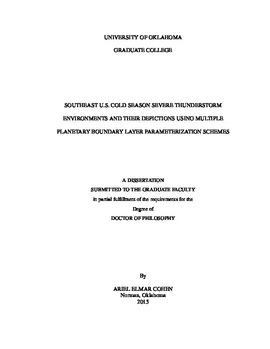| dc.contributor.advisor | Cavallo, Steven | |
| dc.contributor.advisor | Brooks, Harold | |
| dc.contributor.author | Cohen, Ariel | |
| dc.date.accessioned | 2015-12-22T16:56:18Z | |
| dc.date.available | 2015-12-22T16:56:18Z | |
| dc.date.issued | 2015-12-18 | |
| dc.identifier.uri | https://hdl.handle.net/11244/23328 | |
| dc.description.abstract | The primary motivations of this dissertation are to identify meteorological characteristics of the southeastern United States cold season tornado environment and to improve numerical modeling of such environments focused on the parameterization of the planetary boundary layer (PBL). This environment is particularly challenging for forecasters owing to the inherent marginality of one of the necessary conditions supporting thunderstorms: instability. Throughout the first portions of this work, both thermodynamic and kinematic parameters characteristic of the near-storm environment for southeast U.S. cold season tornadoes are found to be different relative to other environments. Numerous thermodynamic and kinematic parameters are found to be statistically significant in this regime, with relatively limited buoyancy and offsetting strong vertical wind shear. As such, this regime is sensitive to small variations in the assessment of buoyancy, of which a relatively greater proportion is concentrated in the low levels compared to other regimes. These findings, along with distinguishable behaviors of kinematic and thermodynamic parameters throughout the daytime heating and nighttime cooling cycles, motivate the need for more thorough investigation of PBL parameterization schemes in this particular regime.
This work then proceeds with a discussion of PBL parameterization schemes and a focused investigation of the performance of nine different PBL schemes in the Southeast cold season severe weather environment by comparing simulated thermodynamic and kinematic profiles to observationally influenced ones. It is demonstrated that simultaneous representation of both nonlocal and local mixing is most appropriate for the southeast U.S. cold season tornado regime. For storm-relative helicity, strictly nonlocal schemes provide the greatest overall differences from observations (underforecast) in a mean sense. Meanwhile, strictly local schemes yield the most extreme differences from observations (underforecast) in a mean sense for low-level lapse rate and depth of the PBL. A hybrid local/nonlocal scheme is found to mitigate these mean difference extremes, while often minimizing conditional bias inherent to strictly local and nonlocal schemes. | en_US |
| dc.language | en | en_US |
| dc.subject | severe thunderstorms | en_US |
| dc.subject | planetary boundary layer | en_US |
| dc.subject | numerical modeling | en_US |
| dc.title | Southeast U.S. Cold Season Severe Thunderstorm Environments and Their Depictions Using Multiple Planetary Boundary Layer Parameterization Schemes | en_US |
| dc.contributor.committeeMember | Carr, Frederick | |
| dc.contributor.committeeMember | Kloesel, Kevin | |
| dc.contributor.committeeMember | Greene, Scott | |
| dc.date.manuscript | 2015-12-14 | |
| dc.thesis.degree | Ph.D. | en_US |
| ou.group | College of Atmospheric & Geographic Sciences::School of Meteorology | en_US |
